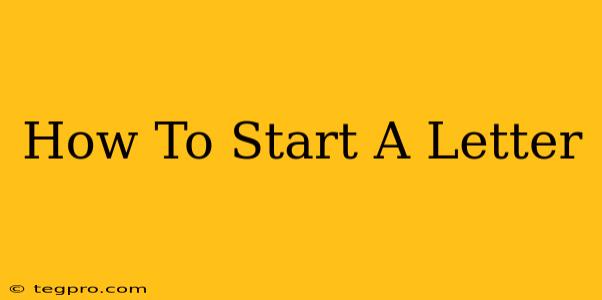How to Start a Letter: Mastering the Art of the Opening
Starting a letter can feel daunting. That first sentence sets the tone for the entire communication, influencing how your recipient perceives your message. Whether you're crafting a formal business letter, a heartfelt personal note, or a casual email, a strong opening is crucial. This guide will equip you with the skills and strategies to write compelling letter introductions, no matter the context.
Understanding Your Audience and Purpose
Before you even think about writing your opening line, consider these key factors:
- Your audience: Who are you writing to? A close friend will receive a vastly different opening than a potential employer or a government official. Consider their relationship to you, their personality, and their likely expectations.
- Your purpose: What do you want to achieve with this letter? Are you requesting information, expressing gratitude, making a complaint, or simply catching up? Your purpose directly impacts the tone and style of your opening.
Effective Opening Strategies for Different Letter Types
1. Formal Letters (Business, Official Correspondence):
- Direct and Concise: Get straight to the point. Clearly state your purpose in the first sentence. For example: "I am writing to inquire about…" or "This letter formally requests…"
- Professional Tone: Maintain a professional and respectful tone. Avoid slang, colloquialisms, or overly casual language.
- Reference Previous Communication (if applicable): If you're responding to a previous letter or email, mention it directly: "Thank you for your email of [date] regarding…"
2. Informal Letters (Personal Letters, Emails to Friends and Family):
- Warm and Engaging: Start with a friendly greeting and a casual, conversational tone. For instance: "How are you doing?" or "It's been too long!"
- Share a Shared Experience: Start with something you both know or experienced recently. This helps create an immediate connection.
- Personal Anecdote: Begin with a short, relatable story to draw your reader in.
3. Persuasive Letters (Cover Letters, Sales Letters):
- Hook: Grab your reader's attention immediately with a compelling statement, question, or anecdote related to their needs or interests.
- Highlight Value Proposition: Clearly communicate the benefit of reading your letter and what the recipient will gain.
- Show, Don't Tell: Instead of simply stating your qualifications, showcase them through specific examples and accomplishments.
Examples of Strong Letter Openings:
- Formal: "I am writing to express my sincere interest in the Marketing Manager position advertised on your website."
- Informal: "Guess what? I finally finished that book we were talking about!"
- Persuasive: "Imagine a world where your business operations run seamlessly, without the constant worry of [problem]..."
Common Mistakes to Avoid:
- Being too vague: Don't leave your reader wondering what your letter is about.
- Using clichés: Avoid overused phrases like "I hope this letter finds you well." (Unless it's truly appropriate for the context)
- Being overly apologetic: Unless absolutely necessary, avoid starting with an apology.
- Neglecting proper grammar and spelling: First impressions matter!
By following these tips and considering your audience and purpose, you can confidently craft compelling letter openings that set the stage for a successful and impactful communication. Remember to practice and refine your skills – the more you write, the more naturally your openings will flow.

